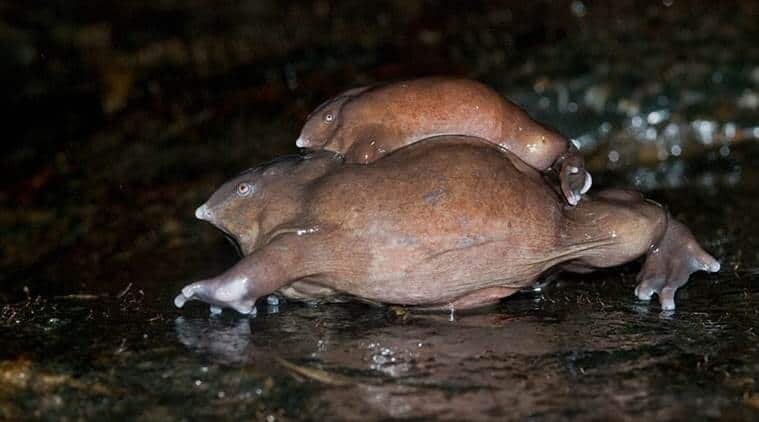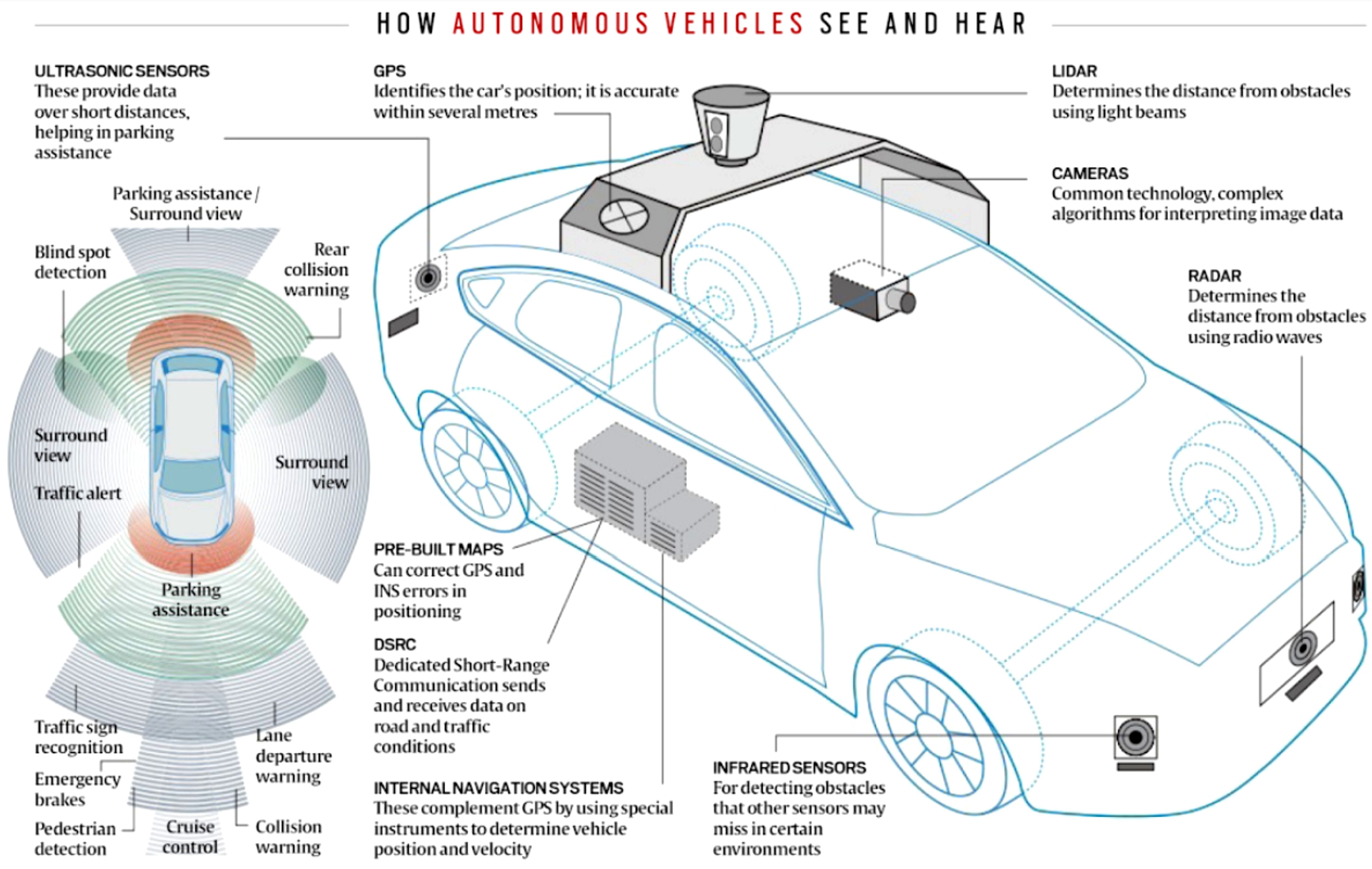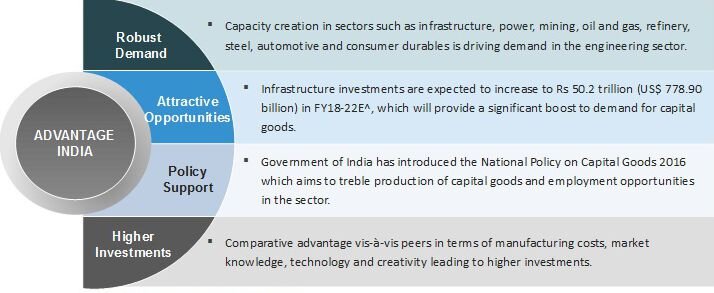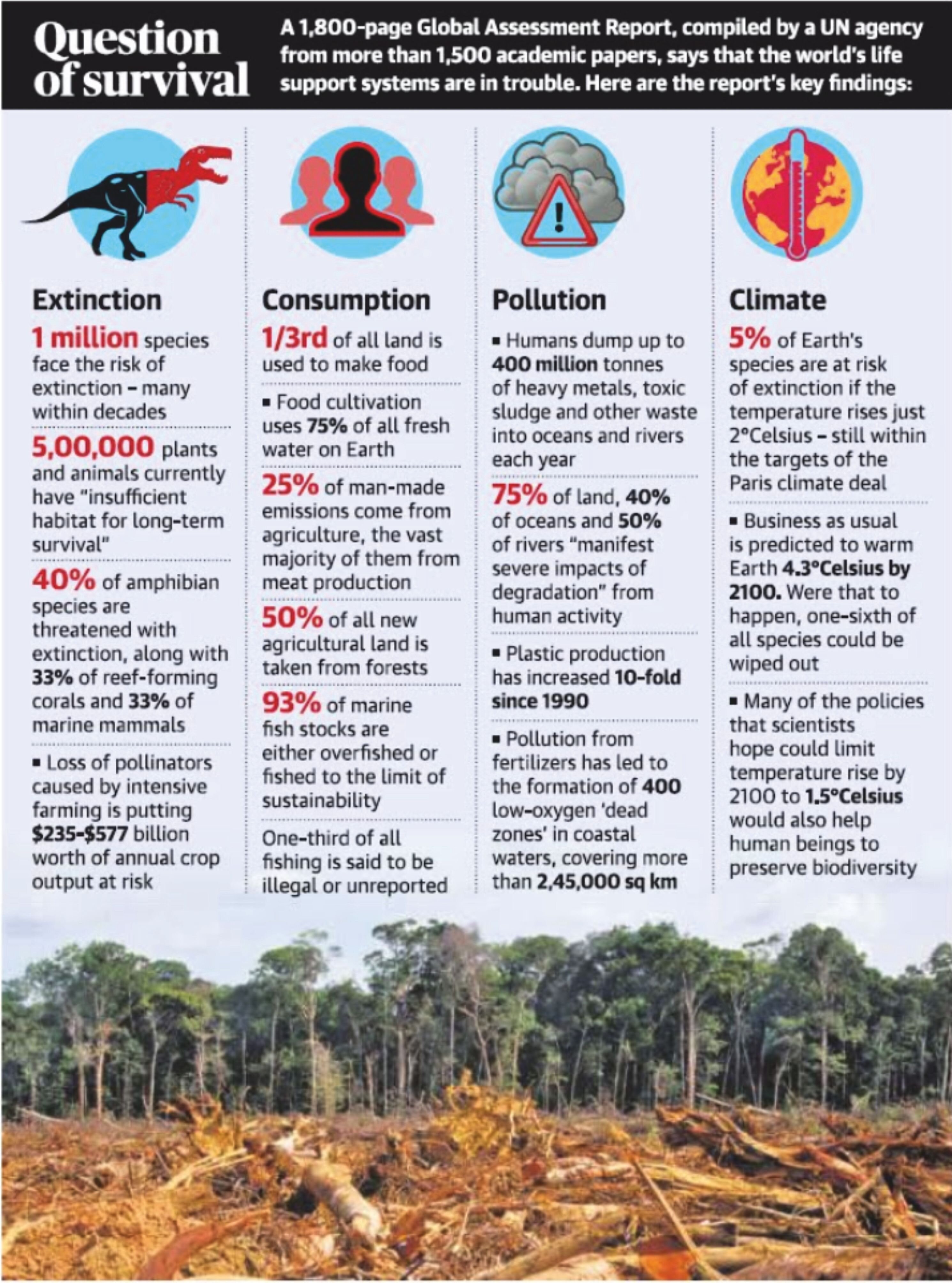Self Driven Cars
Why in the news?
Recently, Elon Musk of Tesla Motors said that Tesla Robotaxis, which will run without humans, will be ready by 2020. However, a lawsuit has been initiated on 1st May by the family of a man killed by Tesla auto driven car last year, exposing limits of driver-less technology.
What are driver-less cars?
Self-driving vehicles are those vehicles in which human drivers are never required to take control to safely operate the vehicle. Also known as autonomous or “driverless” cars, they combine sensors and software to control, navigate, and drive the vehicle.
How do they work?
Most self-driving systems create and maintain an internal map of their surroundings, based on a wide array of sensors, like radar, laser beams, and infrared etc.
Software then processes those inputs, plots a path, and sends instructions to the vehicle’s “actuators,” which control acceleration, braking, and steering.
Hard-coded rules, obstacle avoidance algorithms, predictive modelling, and “smart” object discrimination (i.e., knowing the difference between a bicycle and a motorcycle) help the software follow traffic rules and navigate obstacles.
- The second approach uses Lidar — a remote sensing method that uses light in the form of a pulsed laser to measure variable distances and range — in addition to the traditional sensor suite of radar and camera systems. It requires more data-processing and computational power, but is more robust, especially in tight, traffic-heavy environments.
LIDAR, which stands for Light Detection and Ranging, is a remote sensing method that uses light in the form of a pulsed laser to measure ranges & variable distances. These light pulses—combined with other data recorded by the airborne system— generate precise, three-dimensional information about the shape of the Earth and its surface characteristics.
A LIDAR instrument principally consists of a laser, a scanner, and a specialized GPS receiver. Airplanes and helicopters are the most commonly used platforms for acquiring LIDAR data over broad areas.
What are the benefits of self driverless car?
- Safety: self-driving vehicles could, hypothetically, improve safety and reduce accidents—software could prove to be less error-prone than humans—but cyber security is still a chief concern.
- Equity: Self-driving technology could help mobilize individuals who are unable to drive themselves, such as the elderly or disabled and women.
- Environmental impacts: Accessible, affordable, and convenient self-driving cars could increase the total number of miles driven each year. If those vehicles are powered by fossil fuel, then transportation-related climate emissions could skyrocket. If, however, the vehicles are electrified—and paired with a clean electricity grid—then transportation emissions could drop.
Concerns
Widespread adoption of autonomous vehicles could displace millions of workers employed as drivers, negatively impact public transportation funding, and perpetuate the current transportation system’s injustices.
Technology can be trusted, unpredictability of humans cannot. In such a scenario, in a developing country where there is unplanned infrastructure and a scant regard for traffic rules, the feasibility of driverless cars is far-fetched.
Status of Conservation of Tigers
According to data released by the National Tiger Conservation Authority (NTCA), poaching and electrocution were behind tiger deaths reported in the country.
Key highlights
- Around 40% of India’s estimated 2,226 tigers (2014 census) lives outside the core areas of tiger habitats. These tigers are vulnerable to poaching and come into conflict with humans.
- The data shows a rise in tiger vulnerability with higher number of deaths reported in 2016 in comparison with previous years. According to the data, Madhya Pradesh (148) witnessed the highest number of deaths followed by Maharashtra (107), Karnataka (100) and Uttarakhand (82).
- Poaching cases for illegal wildlife trade is however less but death from electrocution (mostly through fences) has been a major concern from 2016 onwards.
- While 295 tigers died natural deaths (45% of the total), 36 were killed in road or rail accidents.
- Conflict outside sanctuaries, national parks and bio reserves in several places is likely to increase further in the coming years.
Tiger Census in India
- Every 4 years the National Tiger Conservation Authority (NTCA) conducts a tiger census across India.
- The first was conducted in 2006, followed by 2010 and in 2014.
- The Census (2014) had reported 2,226 tigers in the country, up from 1,706 in 2010.
- The fourth tiger census (All India Tiger Estimation 2018-19) estimated to be released in May 2019.
Importance of Fourth Tiger Census 2018
- This 2018 tiger census uses more technology including a mobile app named “MSTrIPES” for the very first time to store information of the counting.
- Another primary focus of the tiger census 2018 is to cover the northeast India that was not included in the previous census.
- For the very first time three neighbouring countries Bhutan, Nepal and Bangladesh are helping in counting the number of tigers all across India, especially in the region with mutual borders.
Note: M-STrIPES (Monitoring System for Tigers - Intensive Protection and Ecological Status) is an app based monitoring system, launched across Indian tiger reserves by the NTCA in 2010. The system would enable field managers to assist intensity and spatial coverage of patrols in a geographic information system (GIS) domain.
Project Tiger and National Tiger Conservation Authority (NTCA)
- Project Tiger was launched in 1973 with 9 tiger reserves for conserving our national animal, the tiger. Currently, the Project Tiger coverage has increased to 50, spread out in 18 tiger range states.
- The tiger reserves are constituted on a core/buffer strategy. The core areas have the legal status of a national park or a sanctuary, whereas the buffer or peripheral areas are a mix of forest and non-forest land, managed as a multiple use area.
- It is an ongoing Centrally Sponsored Scheme of the Ministry of Environment, Forests and Climate Change providing central assistance to the tiger States for tiger conservation in designated tiger reserves.
- The National Tiger Conservation Authority (NTCA) is a statutory body of the Ministry, with an overarching supervisory/coordination role, performing functions as provided in the Wildlife (Protection) Act, 1972.
- The NTCA was launched in 2005, following the recommendations of the Tiger Task Force. It was given statutory status by 2006 amendment of Wildlife (Protection) Act, 1972.
Buffer Area
- Buffer area is the area peripheral to the critical tiger habitat or core area providing supplementary habitat for dispersing tigers, besides offering scope for co-existence of human activity.
- The limits of the buffer/ peripheral areas are determined on the basis of scientific and objective criteria in consultation with the Gram Sabha and an Expert Committee constituted for the purpose.
Ex-situ and In-situ conservation methods
- Ex situ conservation is the conservation and maintenance of samples of living organisms outside their natural habitat. Maintenance of Gene Banks, Seed Banks etc. comes under this method of conservation.
- In situ conservation is conservation of species in their natural habitats. Maintenance of natural habitats in the form of wildlife sanctuaries, national parks etc. comes under this method of conservation.
FMCG Sector Growth to Slow Down
The growth of FMCG sector is set to slow down mainly because of insufficient income growth, low sentiment and liquidity crunch. And this may be due to slowdown in rural demand, reduced farm incomes and low consumer confidence.
FMCG sector in India
- Fast moving consumer goods (FMCG) are the 4th largest sector in the Indian economy.
- There are three main segments in the sector – food and beverages (19%), healthcare (31%) and household & personal care (remaining 50%).
- Growing awareness, easier access and changing lifestyles have been the key growth drivers for the sector.
- The urban segment is the largest contributor to the overall revenue generated by the FMCG sector in India.
- However, in the last few years, the FMCG market has grown at a faster pace in rural India compared with urban India.
Initiatives by Government in FMCG sector
- Approval of 100% Foreign Direct Investment (FDI) in the cash and carry segment and in single-brand retail along with 51% FDI in multi-brand retail.
- 100% FDI allowed in food processing segment.
- These initiatives will bolster employment and supply chains, and also provide high visibility for FMCG brands in organised retail markets, thereby leading to increased consumer
- spending and encouraging more product launches.
- Introduction of the Goods and Services Tax (GST) is beneficial for the FMCG industry. For instance, FMCG products such as soap, toothpaste and hair oil now come under 18% tax bracket against the previous 23-24% rate.
RBI Raises Cap on Home Loan under PSL
RBI has raised eligibility cap on home loans for regional rural banks (RRB) and small finance banks (SFBL) to ₹35 lakh in metropolitan areas and ₹25 lakh in other centres. All such loans will be now classified by these banks as priority sector loans.
- It is done to bring SFBs and RRBs at a level playing field with other Scheduled Commercial Banks.
- The loan limit under PSL is revised: The family income of ₹3 lakh per annum for Economically Weaker Sections (EWS) and ₹6 lakh per annum for Low-Income Groups (LIG) is set, in alignment with the income criteria specified under the Pradhan Mantri Awas Yojana.
Priority Sector Lending
It means those sectors which the Government of India and Reserve Bank of India consider as important for the development of the basic needs of the country and are to be given priority over other sectors. The banks are mandated to encourage the growth of such sectors with adequate and timely credit.
RBI guidelines for PSL for scheduled commercial banks:
- 40% of the total net bank credit should go to priority sector advances.
- 10% of the priority sector advances or 10% of the total net bank credit, whichever is higher should go to weaker section.
- 18% of the total net bank credit should go to agricultural advances. Within the 18 target for agriculture, a target of 8 per cent of Adjusted Net Bank Credit (ANBC) or Credit Equivalent Amount of Off-Balance Sheet Exposure, whichever is higher is prescribed for Small and Marginal Farmers, to be achieved in a phased manner.
- 7.5 of ANBC or Credit Equivalent Amount of Off-Balance Sheet Exposure, whichever is higher should go to Micro enterprises.
Priority Sector includes the following categories:
- Agriculture
- Micro, Small and Medium Enterprises
- Export Credit
- Education
- Housing
- Social Infrastructure
- Renewable Energy
- Others
‘Maveli’ Frog
Researchers have found that the Purple frog (Nasikabatrachus sahyadrensis), lives almost its entire life in underground tunnels, comes out to the surface for a single day in a year to breed and lays its eggs, and returns to the earth’s deepest layers.
- The bloated frog is characterised by a protruding snout and powerful hind legs.
- Mahabali, or Maveli, was a mythological king who ruled over the region of Kerala. The frog is compared with the Maveli due to their similar characteristics thats why given the name "Maveli".
- It is listed as endangered on the red list of the International Union for Conservation of Nature (IUCN).
- It could soon be designated as Kerala’s state amphibian.
Significance
- It’s a unique species and endemic to this part of the southern Western Ghats and cannot be found anywhere else.
- Discovered for the first time in 2003 in the jungles of Kerala, the species sparks feverish imagination among herpetologists worldwide for a number of reasons:
- They believe that the species should be rightly called a 'living fossil' as it’s evolutionary roots suggest it could have shared space with dinosaurs going back almost 70 million years ago.
- It was able to survive such a long period in time, points to its tenacity and could help scientists understand how it’s population may have evolved and learned to overcome the challenges of shifting land masses.
Problems
- The fragile Western Ghats, classified as a biodiversity hotspot and a UNESCO World Heritage Site, is home to thousands of flora and fauna species that are not found anywhere else.
- Rapid deforestation and conversion of forest land into cropland and human settlements intruding deeper and deeper into animal habitats, the incidence of man-animal conflict especially with regards to elephants and tigers is increasing across the region.
- Over 50 per cent of pink frog habitats lies outside the protected areas. The rampant construction of unauthorised check dams leads to submerging of the perennial breeding grounds of the frogs. Additionally, road networks lie close to their breeding grounds and hundreds of cases of road-kills go unreported every year
Conservation
Efforts are made to pronounce the Purple frog as an 'umbrella species' much like the tiger so that the habitat as well as other species, living in the same diversity, can be indirectly protected.
Umbrella Species
Umbrella species are species that are selected for conservation-related decisions because the conservation and protection of these species indirectly affect the conservation and protection of other species within their ecosystem. Umbrella species help in the selection of potential reserve locations, as well as the determination of the composition of the reserve.
UN Report on Species Extinction
- The Intergovernmental Science-Policy Platform on Biodiversity and Ecosystem Services (IPBES) has released the UN report on species extinction. It is estimated that up to 1 million of the estimated 8 million plant and animal species on Earth are at risk of extinction within decades.
Significance of the report
- The assessment is the most accurate and comprehensive review yet of the damage people are inflicting on the planet. And they warn that nature is declining at "unprecedented" rates and that the changes will put people at risk.
- The report identified a range of risks, from the disappearance of insects vital for pollinating food crops, to the destruction of coral reefs that support fish populations that sustain coastal communities, or the loss of medicinal plants.
- Decline of native species in most major land-based habitats by at least 20%, mostly since 1900.
- It emphasizes that business and financial concerns are also threatened. We are eroding the very foundations of our economies, livelihoods, food security, health and quality of life worldwide.
- Key global threats: human’s use of land and sea resources, climate change, pollution and invasive species.
- Ocean ecosystems degrading as temperatures rise towards 2 degrees Celsius above preindustrial levels. Loss of coral reefs to warming and acidifying oceans could cause a collapse in commercial and indigenous fisheries.
Some of the report's notable findings
- Damage extent: 75% of the land environment and 66% of the marine environment impacted due to anthropogenic activities.
- Loss of pollinators: Up to $577 billion in annual global crops are at risk from pollinator loss. Insect pollinators are unfortunately an excellent example of the problems caused by human activities."There's a newly coined phrase for insect declines — the 'windshield effect’.
- Increased risk of floods and hurricanes because of loss of coastal habitats and protection.
- Pollution and waste
- Plastic pollution has increased tenfold since 1980.
- 300-400 million tons of heavy metals, solvents, toxic sludge and other industrial waste are dumped into the world's water systems.
Conclusion
- Biodiversity and nature's contributions to people are our common heritage and humanity's most important life-supporting 'safety net.' But our safety net is stretched almost to breaking point.
- Humans as both the cause of the threat and a target of its risks. As humanity demands ever more food, energy, housing and other resources, they say, it's also undermining its food security and long-term prospects.
- The essential, interconnected web of life on Earth is getting smaller and increasingly frayed.
- Profound economic and social changes would be needed to curb greenhouse gases quickly enough to avert the most devastating consequences of a warming world.
IBPES
The Intergovernmental Science-Policy Platform on Biodiversity and Ecosystem Services (IPBES) is an independent intergovernmental body, established by member States in 2012.
Objective of IPBES: Strengthen the science-policy interface for biodiversity and ecosystem services for the conservation and sustainable use of biodiversity, long-term human well-being and sustainable development.
The windshield effect
Also, the windscreen phenomenon is a term given to the anecdotal observation that people tend to find fewer insects smashed on the windscreens of their cars now compared to a decade or several decades ago. This effect has been ascribed to major global declines in insect abundance.
Important Facts For Prelims (7th May 2019)
Honey Mission
The Khadi and Village Industries Commission (KVIC) has distributed more than one lakh bee-boxes among farmers and unemployed youths across the country in less than two years under its 'Honey Mission' initiative to increase honey production and farmers’ income.
- Under the Honey Mission, KVIC provides awareness, training and ‘Bee Boxes’ along with Bee Colonies to the farmers.
- The mission was launched in August 2017 in line with the ‘Sweet Revolution’.
- The 'Sweet Revolution' was launched in 2016 to promote beekeeping and associated activities.
- According to the KVIC, the Mission has created more than 10,000 new jobs, besides creating around 25,000 additional man-days through the fabrication of bee boxes and honey extractors.
Khadi and Village Industries Commission (KVIC)
- KVIC is a statutory body established under the Khadi and Village Industries Commission Act, 1956.
- The KVIC is charged with the planning, promotion, organisation and implementation of programmes for the development of Khadi and other village industries in the rural areas in coordination with other agencies engaged in rural development wherever necessary.
- It functions under the Ministry of Micro, Small and Medium Enterprises.
Fourth Scorpene class Submarine Vela launched
- The Scorpene-class submarine “Vela”, the fourth of six underwater warships being built in India with French collaboration, has been launched in Mumbai, with an aim to boost Indian capability to defend and secure the strategic sea lanes.
- INS Vela was first commissioned on August 31, 1973 in the Indian Naval Service and continued to serve for 37 years. It was the country’s oldest submarine when it was decommissioned on June 25, 2010.
- A new Vela with modern machinery and technology to guard the seas, has been launched.
- The State-owned Mazagon Dock Shipbuilders Limited (MDL) has entered into a contract for construction and transfer of technology for six Scorpene-class submarines with French collaborator Ms Naval Group (formerly DCNS).
- Before Vela, MDL launched Kalvari, Khanderi, Karanj submarines.
- While Kalvari has been commissioned, the others are at various levels of trials and tests.
Varuna
- 'Varuna', the 17th edition of a joint exercise of navies of India and France, currently underway off the coast of Goa, is the largest ever joint exercise undertaken by the two navies yet.
Significance and scope :
It represents the strengthened maritime co-operation between India and France. With 11 of the two countries’ modern units, including the western fleet’s Aircraft Carrier INS Vikramaditya and French Navy’s aircraft carrier FNS Charles De Guelle, the exercise will focus on interoperability between the two sides.
About Varuna:
- It is an annual exercise.
- It is held in either the Indian Ocean or in the Mediterranean Sea.
France is the Littoral State of the Indian Ocean through the French Overseas region of Reunion, Mayotte & Scattered Islands in the Indian Ocean.
Other Joint exercises between and India and France:
- Shakti: Army (Land)
- Garuda: Air force
GRIHA for Existing Day Schools
Green Rating for Integrated Habitat Assessment (GRIHA) Council recently released a rating tool ‘GRIHA for Existing Day Schools’ to evaluate the environmental performance of existing schools across India.
Key highlights
- The rating familiarises the students with the concepts of sustainability by involving them in evaluating the environmental impact of schools on the environment.
- It will help students and teachers in establishing contact with nature and with each other using the approach of co-creation and understanding.
GRIHA rating
- GRIHA, or Green Rating for Integrated Habitat Assessment, is the national rating system of India for any completed building construction.
- GRIHA is recognised as India’s own green building rating system in India’s INDC submitted to UNFCCC
- It was conceived by TERI and developed jointly with the Ministry of New and Renewable Energy.
- The main objective of the rating system is to help design green buildings and, in turn, help evaluate the 'greenness' of the buildings.
- It is an assessment tool to measure and rate a building’s environmental performance.
- The rating system is based on four parameters:
- Site selection and planning
- Conservation and efficient utilization of resources
- Building operation and maintenance
- Innovation points


